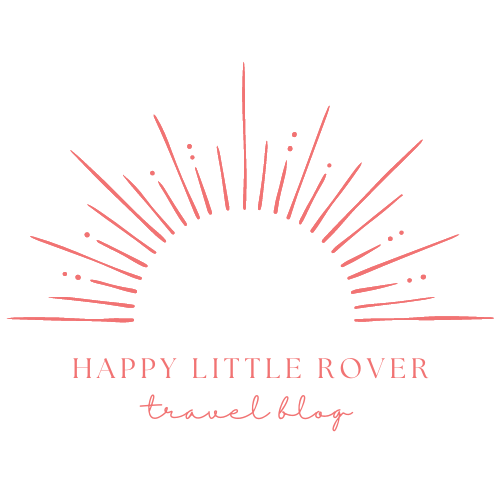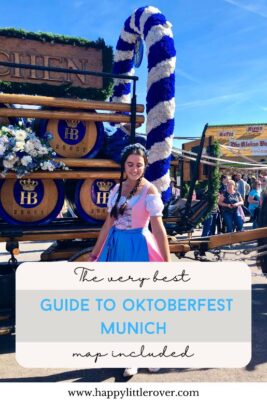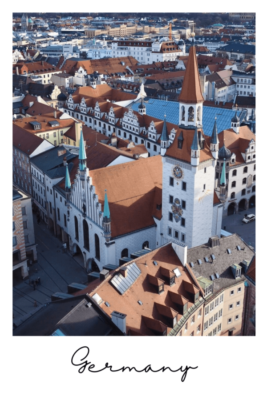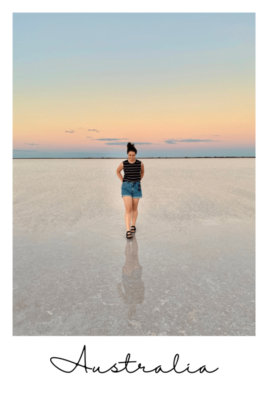The very best guide to Oktoberfest Munich map included
Searching for the perfect guide to Oktoberfest Munich map included, while planning your dream trip to the biggest beer festival in the world?
Wondering how you’ll enjoy yourself if you can’t even read the signs or speak a lick of German, or navigate among the 38 different beer tents?
Well, my friend, you’ve come to the right spot!
I’ve been to the big shindig before, speak conversational German and have a dusty dirndl sitting in the back of my wardrobe.
This guide has all the tips and tricks for you to enjoy Oktoberfest the right way and by the end, you’ll practically be showing the newbies around yourself.
I’ve even added in how you can experience a taste of the Oktoberfest magic even if you won’t be there at the right time of year.
Let’s get going!
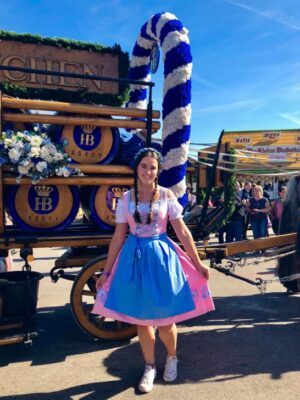
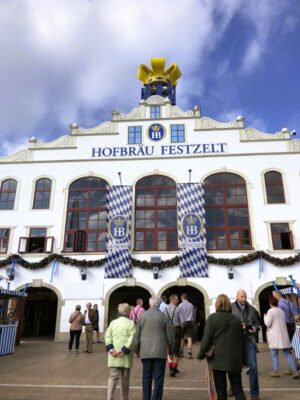
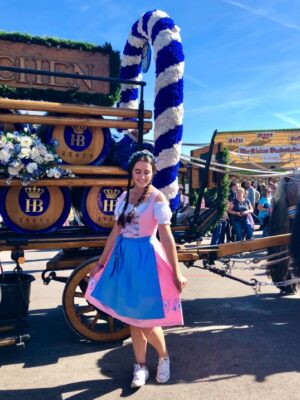
Before you visit the world famous Wiesn
A quick note before we dive into everything you need to know for the best time at Oktoberfest.
If you’re heading to Munich at the same time as the festival, you should book your accommodation ASAP.
Accommodation options are infamous for selling out months in advance when it’s the Oktoberfest period, so do yourself a favour and book in as soon as you’ve decided that you’d like to go.
If things are a bit pricey around the festival meadow itself, have a look a bit further out along public transport lines.
I’ve written up a whole guide to help you on where to stay when you’re attending the world’s largest folk festival, make sure you take a look at that too!
Looking for more info on where to stay in Munich for Oktoberfest? Here’s your guide!
A brief history of Oktoberfest
Let’s dive into a quick history of Oktoberfest before it became the largest beer festival in the world.
It began as a celebration for the good people of Munich following the wedding of the future King Ludwig I and Princess Therese of Saxe-Hildburghausen in 1810.
Featuring raucous horse races, wine and beer, the city came out for a party and had so much fun that they decided to make it a yearly thing.
Originally just set up in the middle of an empty meadow outside the empty walls, now named Theresienweise after the beloved princess, small stands and tents served food and drink.
Over the years, larger tents and more stable structures began to pop up for the festivalgoers’ comfort and eventually reached the giant “tents” with elaborate decorations that exist today.
It’s been missed on a few different occasions due to war or most recently, a worldwide pandemic, but has run pretty much yearly for the last 200+ years.
Even though a large number of international tourists attend each year, up to 75% of the patrons are from Bavaria so you’re still very much enjoying traditional Gemütlichkeit or cordiality with the locals.
Some tents draw more of an international crowd, like the Hofbräu tent or the Löwenbräu tent, then things might feel slightly less Bavarian but still very fun.
The locals refer to Oktoberfest as the Wiesn in reference to the meadow that the festival is held on.
Looking for more historical info about the Bavarian capital? Try this walking tour of Munich out!
Why is it called Oktoberfest when it’s mostly in September?
Originally held to celebrate the royal wedding in 1810, after a few years, it was decided to move the dates a bit earlier as the weather in October is a lot less reliable for an outdoor festival.
And the days are also longer in September, so the festival now takes place mostly in September, often with just the final weekend falling in October.
Each year the dates do change depending on how it fits around set public holidays and the weekends.
It usually runs for 16-18 days and the opening and closing weekends are the busiest times.
On the opening weekend, there’s a colourful parade of dirndls and lederhosen from the city centre to the Theresienweise.
At exactly 12pm, the Oberbürgermeister of Munich is responsible for personally hammering the spout into the first barrel of specially brewed beer, there’s even bets placed on how many strikes they’ll need for the beer to flow.
Once the beer flows out, the 12 gun salute is fired, the mayor calls out ‘O’zapft ist”, Bavarian for its tapped!
Then all the tents can officially begin serving their beer, before this, it’s soft drink only.
What are the opening times for the Wiesn
On weekdays, the majority of the tents are open from 10am – 11:30pm. Beer and food are served until roughly 10:30pm, excluding some of the smaller tents.
On weekends, the tents open from 9am and close around 12am. Beer and food are served until roughly 11:30pm, again depending on the tent. Except for the Wiesn-Schänke and the Weinzelt, which both stay open until 1am.
The food stalls outside the tents – think carnival vibes outside the tents – often stay open just past the big tents closing times so they can take advantage of the merrymakers wanting one last bratwurst for the way home.
The best guide for Oktoberfest Munich, map included: what to pack
You should definitely pack light for Oktoberfest, the official rules state that any bags being brought onto the grounds must be smaller than 3 litres in volume or 20 cm x 15 cm x 10 cm in size.
While there are apparently paid storage facilities for larger bags, I’d definitely advise leaving these in your room and just bringing the essentials with you.
You’ll need to be checked by security personnel on entry to the festival grounds so having a smaller bag will also make your checking process faster.
Bring your mobile phone fully charged, you might also want a powerbank, especially if you’ve got friends who will be in other tents or moving around, the grounds are massive and you can definitely lose people even in the same tent.
Visit an ATM before you come in, the waitstaff don’t carry card machines and almost all service relies on cash, so you might be a very hungry and thirsty visitor until you can find a free ATM machine without too long a line.
September can vary wildly for weather, the 2022 festival was rainy and quite cold, so definitely bring a jacket for when you inevitably need to leave the warm and cheery beer tents.
So here’s your official packing list (if you ask me):
Small backpack or handbag (under 3 litre capacity)
Comfy shoes – the grounds are huge and you’ll likely be climbing over tables to go to the toilet, tricky in high heels
Warm jacket – for when you leave at nighttime and its freezing
Mobile phone (+ powerbank) – for finding your friends again when you lose your table on the way back from the toilets
Cash for the day + cards – your beer and food fund
Room key – might be helpful to return to your accommodation
Public transport ticket – if needed
Sunscreen – the rides, many food stalls and beer garden seats are out in the sun with no shade, no one wants to be sunburnt at a festival
Hand sanitiser – you will definitely get covered in beer/be sticky at some stage
Tissues – probably for beer spillage on you but I won’t judge if you use your apron
What to wear to the Wiesn
While there’s no obligation to wear traditional Bavarian dress to the Wiesn, I found it super fun to get dressed up and put my hair into braids!
For men, lederhosen – literally pants made of thick leather – with braces and a checked shirt is traditional, often topped with a felted green or grey hat.
For the ladies, a dirndl is worn: a festive, embroidered dress with built in corset which traditionally reaches to at least the knees, worn with a lace white half blouse and finished with a colourful apron.
The bow of the apron has a “secret” meaning depending which side you tie the knot on:
On your left = single
On your right = taken or married
In the centre = young girl
At the back = widowed or a server
Of course these are more of a joke than strict criteria but give it a go if you need to fend off too many eager new friends.
You’ll be able to buy yourself an authentic dirndl or lederhosen when you reach Munich, there are shops practically everywhere but be warned that they don’t come cheap!
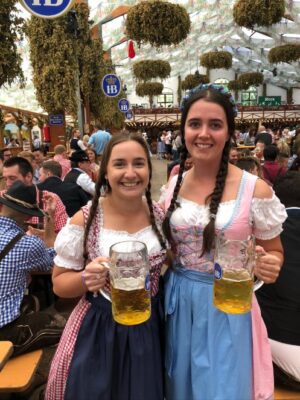
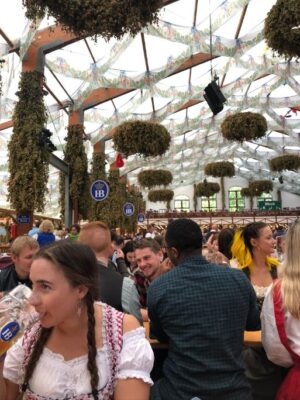
The basic dirndls cost around 80€ with all parts of the costume included but high end versions can be up to 1000€.
Lederhosen will be around 200€ for a set including the shirt for authentic leather, but no one will mind if you just grab a checked shirt and bring along your cream/beige trousers.
Try to steer away from the “Halloween costumes” with cheap printed on aprons etc, these are seen as a bit rude by locals as its cheapening their culture.
Plus, the all in one costumes might not hold up to dancing on tabletops.
If you don’t feel like buying a full outfit that you’ll probably never wear again – I keep telling myself I could wear mine to dinner sometime – feel free to wear regular clothes!
There are also some dirndl and lederhosen rental boutiques around Oktoberfest, rates are around 40-50€ a day, reservations can be made online.
Personally, I think the rate would probably work out similar to buying a dirndl but for lederhosen it might work out cheaper.
Though I have known people to buy theirs secondhand from charity shops or off a friend too.
Don’t forget your comfy shoes, the grounds are massive and as above, you’ll need good footwear for dancing on the benches as the night wears on.
Which tent should I aim for?
The first thing I need you to consider is whether you will be happy drinking only beer or soft drink, for many of the big tents, these are the only options for beverages.
Which might seem strange if you’re used to being able to order say a glass of wine.
There are 17 large tents and 21 smaller tents make up the 38 options for you to find somewhere to perch up at a big communal table and order a Maβ.
Only Armbrustschützenzelt, Marstall, Fischer-Vroni, Schützenzelt, Käfer Wiesnschänke and Weinzelt serve wine and the Wiesnschänke and Weinzelt have mandatory reservations to be able to get in.
If you’re not much of a beer drinker, set your sights on one of the tents above to make sure that you’ll be happy with the drink offerings.
Plenty of people have been caught out after finally getting a spot in one of the beer only tents and then finding out that they only have a choice of beer or soft drink.
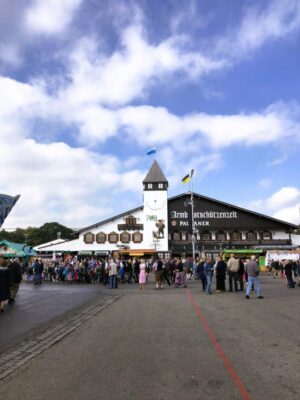
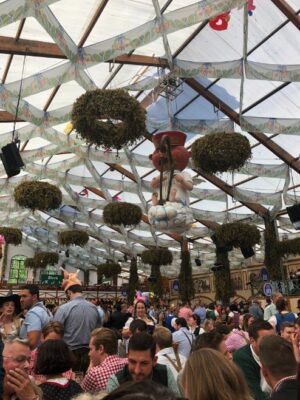

The biggest and best tents are:
Hacker-Pschorr Festzelt: ~6800 inside, 2500 outside in the beer garden.
Known as Himmel der Bayern or Bavarian Heaven, this is one of the most popular tents and commonly fills up in the afternoon. Boasting colourful murals of Munich and a ceiling painted to look like clouds against a blue sky. On the final Sunday, sparklers are handed out for the big finale event.
Hofbräufestzelt: ~6000 seats inside, 3000 outside in the beer garden and standing room for 1000.
One of the more famous tents among the international community, you’ll find plenty of fellow travellers here enjoying the blue and white tent decked out with hops. And even an angel Aloysius hanging from the ceiling. Serving up some of the cheaper food at the festival and specially brewed Hofbräu beer.
Schottenhamel Tent: ~6200 inside plus 2700 outside in the beer garden
This is where it all begins, the first keg of beer is officially tapped here by the mayor of Munich each year to begin Oktoberfest. A favourite amongst the young folk of Munich, you’ll find Bavarian classics on the menu.
Schützen Feszelt: ~5100 inside, 1400 outside in the beer garden
Another tent for the marksmen, this formerly cosy hall hosts a shooting competition which you can observe and enjoys lovely views over the Ferris wheel and festival grounds. You’ll also find suckling pig being served up here beneath a colourful ceiling.
Entry into all the large tents is free but with over I would definitely advise getting there early so you can nab an unreserved seat, each tent must keep a proportion of seats open for walk in visitors.
But with over 600,000 patrons visiting each day and only around 80,000 seats, you can see that the maths doesn’t quite add up.
If you’re very organised, seat reservations can be bought on the official websites of the beer tents around January through to March for a weekday visit, forget about competing with the locals for reservations on the weekends.
However, the reservations come with a catch, you’ll need to reserve for the whole table of 8-10 people and fill up the spots, each spot on the table costs around 30-50€.
You’ll get the value of these reservations back in food and drink vouchers but you can see how booking a table is an expensive venture.
You can, of course, pay for your table online and the booking is good for around 3-4 hours, usually its fine to stay on your table unless there is another booking following yours. Don’t be tempted by cheaper tickets on reseller sites, these are likely to be fakes.
When should I arrive at the tents?
Check out the official “barometer” for how busy the days are likely to be and plan your visit accordingly.
This one is for the 2023 festival but you get an idea of what the attendance numbers are like throughout the two weeks.
But if you’re visiting on a weekday, getting to the festival grounds around 10:30am and heading for the tents will be fine to grab an unreserved table.
On weekends, you’ll want to be lining up around 6am to have a chance of grabbing a free table and I would not recommend visiting on a weekend if you can avoid it.
You’ll be standing around for hours waiting for a table and may still not be lucky enough to get one.
Try the beer gardens if the weather is nice or you may have luck if there’s just 1-3 of you at squeezing onto a table.
Be polite and you’d be surprised during the week, especially if you come across a table with other travellers.
If it’s locals, you can test out your German by asking “entschuldigung, ist hier noch frei” (excuse me, is this seat still available) if it looks like there’s plenty of space on the table, don’t be offended if the answer is no!
Top tip: Look for a table with signs that say “Nicht Reservierter Bereich” to be sure that you won’t be removed by a group with a booking.
I’d recommend two days in total to enjoy the infectious atmosphere of the festival and you’ll get to experience the vibe across two different tents.
But I’ll totally understand if you’re all Wiesn-ed out after the first day, drinking for 10+ hours is a drainer!
Your dedicated map for the Munich Oktoberfest
I’ve included this handy map, showing all the big tents with some quick snippets of info for you so you can easily find your way around the huge grounds.
Plus navigate straight to the tents where your friends are waiting for you with a Maβ of golden beer.
What to eat at the Wiesn
The exact food served will be different depending on which tent you end up in, but you do need to be seated in order to be served food.
Otherwise you might need to take advantage of the food stands outside the beer tents if there aren’t any seats available.
Expect bratwurst and roasted fish stands, along with the usual carnival food. Giant pretzels and gingerbread hearts also feature heavily.
Once you’ve found your spot at the table, the next step is of course to attract your servers’ attention so you can snaffle a stein!
Most of the time, especially if you come at a calmer time of day, they’ll make their way over to you shortly as they see you sitting down.
If it’s busy, you might need to politely raise your hand or get someone on the end of the table to wave them in as they bustle past.
They’ll come and ask what you want to order, there’ll be menus scattered on the long tables for you to read off.
You’ll order and then pay the server directly in cash, they’ll hand you your change.
I was told to tip your server a few extra Euros so they come back to you more often than the other tables but I’m not sure how well this works if everyone is tipping extra!
They’ll return with your food/steins/Obatzda and you can enjoy your taste of Bavarian hospitality.
Cost of food and drink at Oktoberfest 2023
Inside the tents, you can expect some Bavarian classics to be gracing the menus and many of them offer lunch specials at a reduced price during the week.
Which is handy for our wallets, seeing as a Maβ of beer will set you back 13.60€ this year.
Using the Hofbräu tent as an example, at least one dish each day is set at 9.90€ on the lunch menu, ie. Braised venison ragout on Thursdays.
The evening or main menu is slightly more expensive at 22€ for a roast pork knuckle or 26.50€ for ½ a grilled duck.
Of course your day will become more expensive the more litres of beer that you drink, so your wallet and your head will thank you in the morning if you decide to stick to the cheaper soft drink options.
The popular Radler option has a mix of Oktoberfest beer and lemon soft drink, toning down the alcohol content quite a bit from the 6% that the festival beer is brewed for. And it might be a bit more palatable for those not so keen on been, though it will still cost you the same as a regular Maβ.
You’ll find snack food is cheaper outside the tents but once you’re inside, it’s best to stay seated and cough up the extra few Euros if you can afford it.
If you choose to go outside and the tent fills out while you’re out there, the bouncers won’t let you back in. Even if all your friends are at the door telling security that you’re a great person.
So, if you’re lucky enough to find a seat in a tent, assume that you will be staying there for the long haul and bring enough cash for rounds of drinks and food for lunch and dinner.
Assuming that you’re eating both meals, and enjoying 7 rounds of steins throughout the day, that brings us to around 130-140€. More than you might think!
Fun fact: An experienced bartender at Oktoberfest takes on average 1.5 seconds to fill a Maβ or stein with a litre of beer. In 2022, over 5.6 million litres of beer were served throughout the beer tents, pretty impressive!
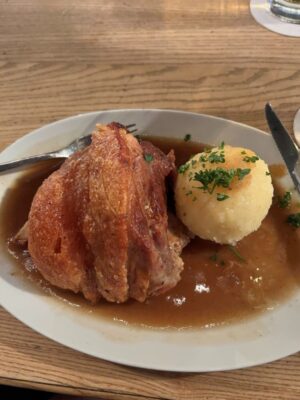
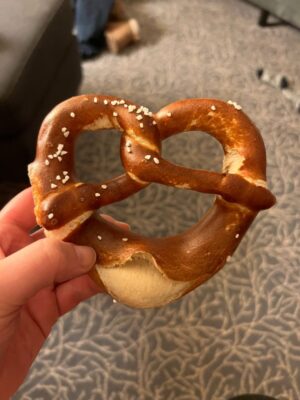
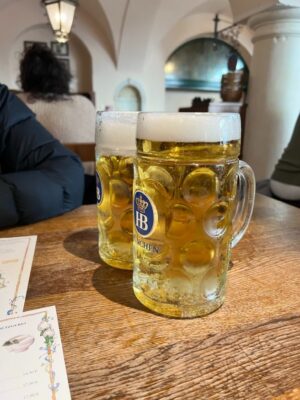
Atmosphere in the tents:
Initially things will be nice and calm in the tents, just some merry oompah music coming from the traditional brass band playing in the middle.
You might notice a certain song is played and accompanied by everyone swaying and singing along as it calls for a toast to the very Bavarian quality of Gemütlichkeit, followed by everyone counting to three (in Munich dialect) as a crowd and toasting together.
As the day goes on, the music will become more and more lively, including dancing on the benches.
When I visited Hofbräufestzelt, the final act was an ACDC cover band, slightly surreal as an Australian to be dancing in a Bavarian beer tent to Aussie pub rock!
I’d advise staying to the end of the night if you can, the atmosphere gets better and better as everyone gets merrier.
Top tip: Dancing on the benches is welcome as the nights go on but not on the tables, you might find that your waitress summoning her friends the security guards to tell you to get down or remove you from the tent altogether.
What about if you won’t be in Munich at the right time? A back up option
In case you can’t make it to Munich in the last two weeks of September, there’s a great alternative right in the heart of the city.
And you’ll enjoy some cheaper accommodation rates compared to visiting when the Wiesn is on.
Head over the Bavarian government owned Hofbräuhaus in the old town or Altstadt, you’ll see the jumbo HB lettering glowing on the side.
With waitstaff kitted out in festive dirndls and lederhosen all year round, live oompah music to delight your ears and a very similar menu to what is served in the HB tent, you’ll be in (almost) Oktoberfest heaven.
Settle in with a crispy pork knuckle, order a Maβ of golden beer and sing along with the band, this is as close to the festival as you can get!
There are also a few other equivalent festivals around Germany, such as the Stuttgart Cannstatter Wasen or Bremen’s Freimarkt, which might fit in with your plans better!
Wondering where to go after Hofbräuhaus? I’ve got the best 3 day itinerary of Munich just for you!
You’ve reached the end of the best guide to Oktoberfest Munich map included.
I hope you’ve enjoyed this comprehensive guide, map included, to Oktoberfest, Munich and you’ve now got your visit all planned out, dirndl and lederhosen too!
I’d highly recommend getting onto your accommodation booking early, make sure you’re bringing a little bag with your essentials (no glass) and you’re prepped for a big day if you don’t have table reservations.
Also don’t forget to pace yourself on the strong beer when it’s coming in a litre at a time and remember to eat something!
I hope you have the most marvellous time at Oktoberfest, it truly is an experience to be remembered.
Don’t forget to pin this for later and send it to your favourite person who’s coming with you!
